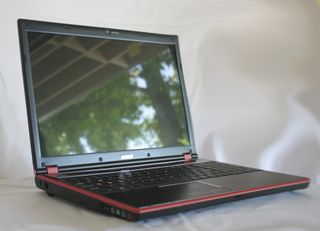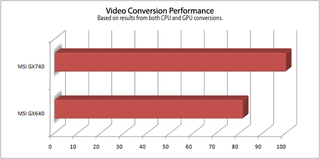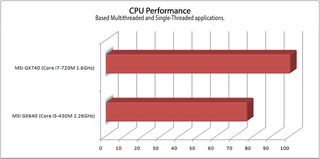Gaming Notebook: 15-Inch Vs 17-Inch
Problem: Find a cheap, powerful gaming notebook—and choose between the 15-inch or 17-inch options. Looking at MSI’s decent options, we weigh pros and cons.
Multimedia and Heavy Computing

When comparing laptop form-factors, one of the key features to consider is the screen size. This may seem obvious, given that the form-factor is generally defined by and given in terms of the size of the display, and one of the biggest reasons to consider a larger display is for multimedia purposes.

It goes without saying that when watching a movie, the bigger the screen, the better. No one would bother spending $10 to watch a movie in a theater if that weren't true. While both the GX640 and GX740 have screens of the same resolution (1680x1050), the GX740's larger screen adds more to the movie-watching experience. The GX740 also offers significantly better sound quality, utilizing optimized speaker placement and the addition of an integrated subwoofer. Of course, this is all academic if you have an HDTV and intend on watching movies via HDMI, which both systems have. If you intend to watch any movies while on the go, you may even want to consider the smaller GX640, just to ensure that the battery lasts through the whole movie.
If a larger screen appeals to you for photo and video editing, the GX740 not only has a larger screen, but also gives you the hardware to make your editing experience even better. With optimized multithreaded programs, such as advanced video converters and 3D rendering software, the GX740 can perform up to 30% faster than its smaller sibling can. The same holds true with GPU accelerated processing, available in some video converters and prevalent in physics simulation software. ATI's own Avivo Video Converter runs up to 35% faster on the GX740 than the GX640.


If you're into multimedia, whether you like to watch it or edit it, the 17-inch form-factor of the GX740 makes a very good fit.
Sign up to get the BEST of Tom's Guide direct to your inbox.
Get instant access to breaking news, the hottest reviews, great deals and helpful tips.
Current page: MSI 17 Inch Laptop Better for Gaming, Multimedia - Tom’s Guide
Prev Page Gaming Laptop Performance - Impact of Size - Tom’s Guide Next Page Gaming Performance Benchmark - GX640 vs. GX740 - Tom’s Guide-
quantumrand I went back and forth between these two laptops more times than I can count. I'm not a hardcore gamer by any means, but I do like to play the latest games from time to time. In my case, battery life wasn't really a concern since I rarely use my laptop away from a plug, so it was really no holds barred between the two.Reply
On the one hand, the GX740's quad core CPU with hyperthreading was a huge selling point for me. I do a lot of video converting as well as 3D modeling, so 8 cores is pretty sweet. The size of the thing is pretty extreme though and takes up almost all of my available desk space, leaving little room for my mouse, lol.
On the other hand, the GX640 is very similar to my current laptop, the GX620. It's the same size, same design, same layout, so switching to it would be very simple. It still has plenty of power to be more than useful, but compared to the GX740 it feels like a big hit to take.
When it all comes down to it though, the GX640 just offers the best performance per price of anything I've seen. I'm by no means a big spender, so at the end of the day, I have to go with the best deal. -
Trueno07 I have an older MSI gaming notebook (it's not really that old, only a year, but they don't make them anymore) and i love it. It hasn't given me any trouble, and aside from some wear and tear on the keyboard (all my fault :D) it's a fantastic performer.Reply -
stewartwb This is an interesting review, but it seems dangerously close to being an advertisement for MSI, with just a token mention of another vendor in the closing paragraph.Reply -
rohitbaran Both the MSI laptops are great performers and coupled with 3 year warranty, they should be giving Alienware a run for their money.Reply -
cknobman Awesome review and comparison.Reply
Stewart: Although I understand your point I think it would be very hard to find another 15 inch laptop with equipment that high spec for such a low price (and likewise for the 17 incher outside of the asus consideration) which makes it easy to explain why we are only seeing MSI. Not to mention Toms can only review the equipment they are given so if no other vendors offered a laptop for a review then MSI deserves any adverts they are getting. -
quantumrand snorenice advertisement, where are the game benchmarks.Reply
It seems like the content management system doesn't like certain links. The benchmark data can be found here: http://spreadsheets.google.com/ccc?key=0AlI_WGE7CQWXdDExTkE5ZHQxOC10eE1pR19Cd0VRLVE -
Tomsguiderachel This was not a paid advertisement--the writer selected these laptops to illustrate the 15 vs 17 issue for performance-oriented laptops. Truthfully, there aren't many comparable products in this price range, but if you know of some please feel free to let us know in this comments section. Also, keep in mind that we usually limit our reviews to new products--we were unable to find any recent product launches in the same price range/category.Reply
Thanks for reading,
Rachel Rosmarin
Editor, Tom's Guide -
ghostofanonion Xan I just say the only thing beastly about tuhe i7-720 is the price. It's no where near the makrketing hype. In saying that I'm quite pleased the performance of my system (i7-720, 8gb, 5870) I just didn't see the raw power these reviews are promising.Reply -
quantumrand ghostofanonionXan I just say the only thing beastly about tuhe i7-720 is the price. It's no where near the makrketing hype. In saying that I'm quite pleased the performance of my system (i7-720, 8gb, 5870) I just didn't see the raw power these reviews are promising.Reply
You're definitely right. In terms of raw power, these laptops certainly don't compare to the possibilities of a similarly priced desktop. No laptop would. Just looking at ATI's Mobility 5800 series makes it plainly clear (the Mobility 5800 is dreadfully similar to the 5700 desktop core).
But when it comes to laptops, these two systems really stand out, both in terms of performance and price. In my opinion, they're a perfect fit for any serious gamer who likes to LAN it up with his friends.
